The Best Backpacking Sleeping Bags for Thru-Hiking of 2023
We’ve established the best thru-hiking homes (tents!), beds (sleeping pads!) how to carry them (packs!) and now it’s time to choose your comforter (sleeping bag) for the next five to six months of your life. It’s a crucial piece of gear because it 1) weighs a lot, 2) usually costs a lot, and 3) without it, you’re in danger of a cold, miserable night at best or life-threatening exposure at worst.
Because a crappy night’s sleep is the fastest way to ruin the trip of a lifetime, you should opt for one of the best thru-hiking sleeping bags for your next hike. In assembling this list, we considered factors like weight, warmth, price, materials, and features to identify top-performing bags for every type of backpacker.
Looking for a quilt? Check out the Best Quilts for Thru-Hiking instead.
Quick Navigation
Best sleeping bags for thru-hiking:
- Feathered Friends Tanager (Highest Fill Power)
- Therm-a-Rest Hyperion 20 (Lightest Sleeping Bag)
- Western Mountaineering UltraLite (Best All-Around)
- REI Co-Op Magma 15 (Popular with Thru-Hikers)
- Marmot Trestles 15 (Best Budget Sleeping Bag)
- NEMO Riff 15 (Best Sleeping Bag for Side Sleepers)
- Big Agnes Torchlight UL 20 (Most Versatile Sleeping Bag)
- NEMO Forte 35 (Best Synthetic Backpacking Sleeping Bag)
- Kelty Cosmic 20 (Best Budget Down Sleeping Bag)
Best Sleeping Bags for Thru-Hiking: FAQs
Sleeping bags are expensive and weirdly complex. Before we get into the best backpacking sleeping bags for thru-hiking, here are a few pointers to help make the decision easier.
What Temperature Rating Should I Use for Thru-Hiking?
Most Triple Crown trail thru-hikers should be fine with a bag rated between 15 and 30 degrees. You know yourself, though. If you tend to sleep cold, opt for something rated to a lower temperature. When in doubt, the rule of thumb is to go with a bag rated at least 10 degrees lower than the lowest temperature you expect to encounter on your hike. Alternatively, carry a lighter bag supplemented with a liner.
It’s important to keep in mind that the listed ratings usually denote the temperature at which an average person won’t get hypothermia (“limit”), not the temperature at which an average person stays warm and comfy (“comfort”). Check the label—the comfort temperature might be 10 degrees warmer than the number given in the model name.
For instance, the Therm-a-Rest Hyperion 20 might lead you to believe, based on its name, that it will keep you warm to 20 degrees. In reality, it will keep the average person from shivering at 20 degrees, but that’s a far cry from being toasty-toes. The comfort limit of the Hyperion 20 is actually 32 degrees.
Women’s bags are often an exception to this rule: they tend to use the comfort rating as the advertised rating.
Learn more about temperature ratings in The Ultimate Guide to Backpacking Sleeping Bags and Quilts for All Budgets.
Sleeping Bag or Quilt?
Quilts are essentially sleeping bags without the underside, saving the weight of a full-length zipper and part of the bulk. The idea is that when you lie on a down-insulated sleeping bag, the down compresses enough that it doesn’t work to insulate, and users do just as well with a sleeping pad for insulation from the ground.
The general consensus for most quilt models is that they are not quite as warm as a mummy bag with the same rating because they are open and tend to let in more drafts. Even so, quilts are growing in popularity compared to fully enclosed bags, with just 4o percent of respondents to our annual Appalachian Trail Thru-Hiker Survey using bags during their thru-hike.
Quilt aficionados appreciate the weight savings and freedom of movement their sleep system affords them. If you opt for a quilt, be sure to get an adequate width to avoid drafts. If you tend to sleep colder and prefer a snug, tucked-in feel, go for a traditional mummy bag.
What’s the Difference Between Men’s and Women’s Sleeping Bags?
There are a few differences in women’s-specific vs. general sleeping bags, though nothing critical. Women’s bags have a different down distribution based on a general understanding of heat loss—for instance, a women’s-specific bag might have a higher concentration of down around the torso and in the footbox as opposed to a generic bag.
Women’s-specific bags are also wider in the hips and narrower through the shoulder, and are often smaller in width and length. This means less empty space to heat up and keep warm.
Women’s bags are more likely to use realistic temperature ratings in their branding. For instance, the women’s REI Magma 15 bag is rated to keep an average cold sleeper comfortable at 15 degrees, while the men’s Magma 15 is only rated to keep hypothermia at bay for an average warm sleeper at the same temperature.
Moral of the story: if you want the warmest possible version of a sleeping bag and your proportions allow it, opt for the women’s model.
Wait, I’m Confused About Fill Power Vs. Fill Weight
So are most people.
Fill power refers to the space one ounce of down occupies in a cylindrical container when allowed to loft to full capacity. High-quality down has a higher loft than lower-quality down, which means you get more warmth for less weight. I.e., 900 fill has a better warmth-to-weight ratio than 700 fill. Look for sleeping bags between 700-950 fill power. Anything more than that is just fluff.
Down or Synthetic?
Down has superior compressibility and a better warmth-to-weight ratio compared to synthetic fill, making it the ultralight insulation of choice. On the other hand, it’s also much more expensive and won’t provide much warmth if it gets wet.
Duck down is less expensive than goose down, but you won’t find duck down loftier than about 650-fill. It also has more of a smell when it gets damp. In contrast, goose down is available in 850, 950, and even 1000-fill. Some down has a hydrophobic treatment that allows it to retain some loft (and by extension, warmth) if it gets wet.
Synthetic (polyester) insulation goes by branded names like PrimaLoft and Polartec. It’s bulkier and heavier than down, but this might be a worthy tradeoff for budget-conscious hikers since it costs a fraction of what down costs.
Can I Relax if My Down Has a Water-Resistant Treatment?
You can sort of chill out. We recommend you opt for a sleeping bag with a treated down to give yourself some leeway if the bag gets damp or comes in contact with condensation on the walls of your tent. Treated down will retain its loft and insulating abilities for significantly longer than untreated down, but you still need to prevent your bag from getting saturated. There are a few varieties of treated down on the market—keep an eye out for Nikwax, DriDown, DownTek, and HyperDry.
If you’re really concerned about your down getting wet, a synthetic bag is another option, but those models tend to be bulkier. Synthetic fill has come a long way in the past few years, but down still has a higher warmth-to-weight ratio overall.
Features to Look For in the Best Thru-Hiking Sleeping Bags
More features typically translate to more weight. If you’re planning a long-distance trek, you may want to forgo some of the below features in favor of weight savings.
Fill weight: The amount of insulation in a sleeping bag determines how warm it will be. Different insulation types (synthetic, down of varying fill powers) all have different weights for the same amount of loft, but looking at the fill weight is a good starting point when researching a bag’s warmth.
Fill ratio: This is the fill weight divided by the overall weight of the bag (including shell fabric and zippers). A bag with a lower ratio can still be warm—it might just mean it has more zippers or thicker fabric. However, the higher the fill ratio, the more efficient the bag’s design.
Two-way zipper: Half zippers save weight, but they’re not versatile. With two-way full-length zippers, you can open up the bottom to vent heat on warm nights.
Draft collar: The best backpacking sleeping bag in the world won’t do you much good if cold air can seep in through the giant hole at the top of the bag. So make sure you get an insulated draft collar that hangs around your neck and shoulders to cut airflow.
Stash pocket: In cold weather, you’ll want to sleep with your electronics, water filter, and maybe a few other things. An internal pocket goes a long way toward maintaining order in your bag once you move all your random shit inside.
Water resistance: DWR shell fabrics, water-resistant down, waterproof footboxes… you get the picture. Anything you can do to avoid a sodden sleep system is a win. And on that note…
Dark colors: Despite your best efforts, your sleeping bag is going to get wet at some point. When it does, you’ll need to find a sunny patch of trail and dry that sucker out ASAP. That’s why the best backpacking sleeping bags for thru-hiking are dark-colored.
Black/dark-colored bags absorb heat and dry faster than lighter colors. This one simple feature will save you time and help keep your bag in decent shape.
Pad sleeve: Some models from Big Agnes swap the bottom insulation for a stretchy fabric sleeve designed to hold an inflatable pad. This is great if you’re sick of sleeping on what feels like the world’s most boring Slip ‘N Slide.
Pro tip: The low-budget solution to the slippery pad problem is a few strategically placed dots of silicone seam sealer on your pad to create extra friction.
Responsible Down Standard: If you opt for a down bag, make sure the insulation was ethically sourced by checking for RDS accreditation.
About Our 2023 Picks
Sleeping bags are simpler than tents and packs. They’re essentially bags of feathers, and the biggest variable will be choosing between a quilt or mummy bag (see above). There’s sufficient diversity in the sleeping bag/quilt market that we’ve chosen to break traditional sleeping bags and quilts into separate listings. For this review, we’ll focus on traditional mummies.
We’ve chosen a selection of bags that are lightweight, durable, and highly customizable—thru-hiker-centric models with good warmth-to-weight ratios. Be sure to check out all of the customization options for each model to fit your particular needs—many brands (especially cottage industry) have build-your-own options for fill power, temperature rating (all listings are in Fahrenheit), width/length, and even color.
Since so many of these models have an array of customization options, we’ve based our specs (price, weight, fill, dimensions, etc.) on the stock model.
No matter what you choose, remember to treat your sack-o’-fluff with care. A sleeping bag is a big and important investment. It can mean the difference between a comfortable night’s sleep and sheer misery, keeping you safe in plummeting temperatures. During sunny breaks, shake out your sleeping bag and let it dry in the sun. As often as possible, remove it from the compression sack to allow a full loft, and never store it compressed when you’re not hiking.
The following sleeping bags are listed in no particular order.
The Best Sleeping Bags for Thru-Hiking of 2023
Feathered Friends Tanager (Best Warmth-to-Weight Ratio)
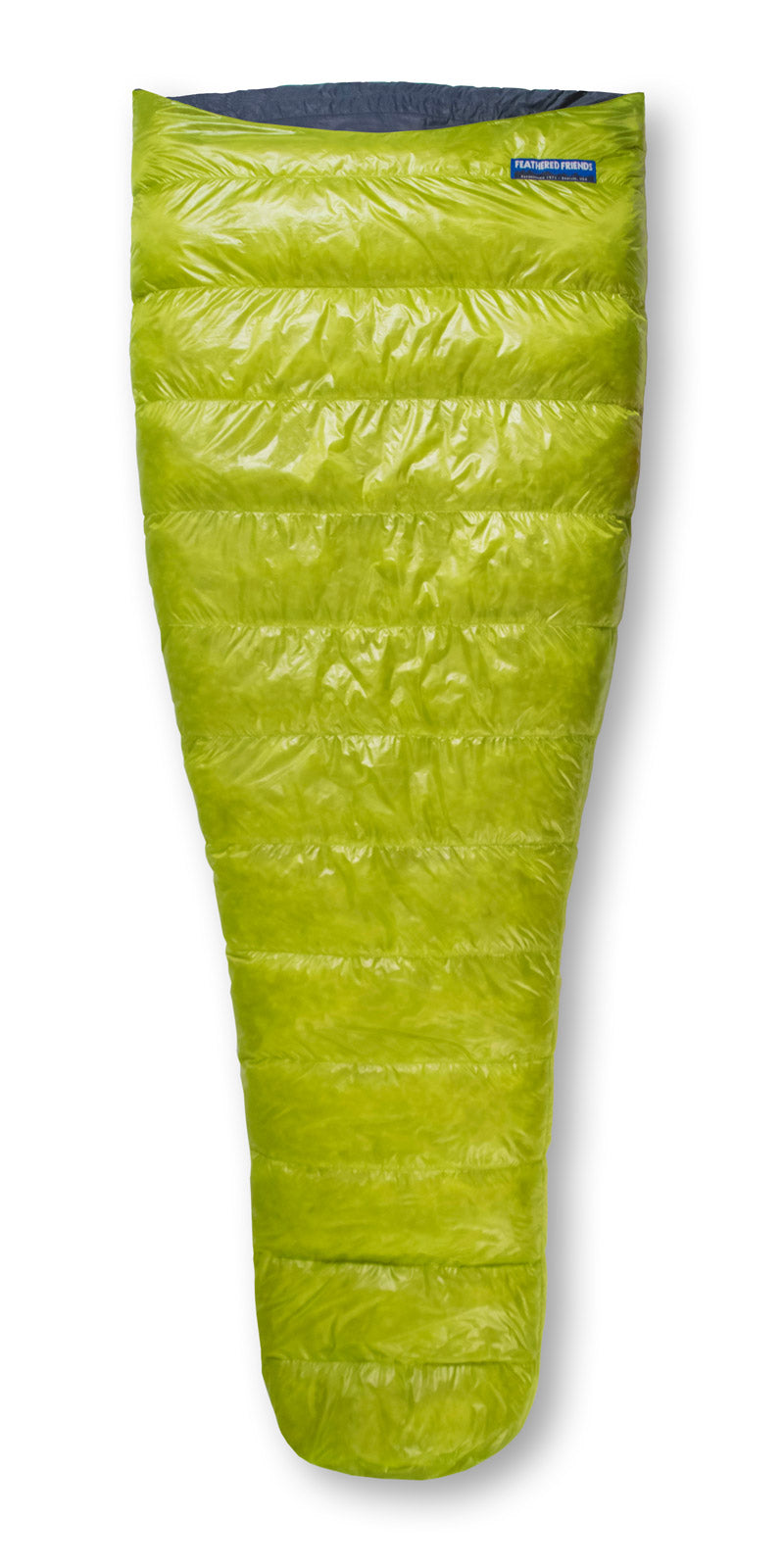
Best sleeping bags for thru-hiking: Feathered Friends Tanager.
MSRP: $429
Weight: 18.6 ounces
Fill Weight: 12.6 ounces
Fill Ratio: 0.68
Temperature Rating: 20 degrees but FF’s ratings are generally considered accurate for comfort
Insulation: 12.6 ounces of 950-plus-fill down
Details
Made in Seattle, Feathered Friends bags come with a hefty price tag, but the craftsmanship, customer service, and overall quality make their bags a worthy investment. The Tanager weighs scarcely more than a pound—less than many 20-degree quilts—but has many of the draft control benefits of a traditional sleeping bag.
The Tanager saves weight over a traditional mummy by using ultralight materials and eliminating not just the bulky hood, but also the zipper. You enter and exit this by shimmying through the top opening.
A full 68 percent of this bag’s 19-ounce weight is devoted to down feathers, earning it the Best Warmth-to-Weight Ratio award.
Materials and Features
Insanely floofy 950-fill down is sandwiched between a Pertex Endurance 7D water-resistant shell and a 15D ripstop nylon liner. The collar has a drawcord so you can cinch it around your neck during cold weather.
Nobody’s Perfect
The Tanager’s hoodless, zipperless design isn’t for everyone: scooching in and out the sleeping bag’s narrow top opening can be tough. Some users also find it quite narrow. The difficulty of getting in and out or moving around inside the bag may lend itself to sleeping bag claustrophobia, even though it lacks a constricting hood.
The Tanager is designed to be paired with a lightweight, hooded puffy like the Feathered Friends Eos for optimal warmth on cold nights, which could be a drawback for folks who prefer not to sleep in their jackets. For a more traditional mummy design from Feathered Friends, check out their Hummingbird model.
Shop the Feathered Friends Tanager
Therm-a-Rest Hyperion 20 (Lightest Mummy)

Best sleeping bags for thru-hiking: Therm-a-Rest Hyperion.
MSRP: $550 (reg. length)
Weight: 20 ounces (reg. length)
Fill Weight: 12.5 ounces
Fill Ratio: 0.63
Temperature Rating: 20 degrees
Comfort Rating: 32 degrees
Insulation: 12.5 ounces of 900-fill Nikwax hydrophobic down
Details
Therm-a-Rest upped their sleep system game back in 2019. They avoided the pitfalls of generating overly engineered systems, opting to follow along the lines of their fan-favorite NeoAir sleeping pads: lightweight, streamlined, and optimized for long-distance hikers. This sleeping bag is ultralight, packable, and straightforward—even the zipper is only half-length.
The temperature rating is accurate (20 degrees limit, 32 degrees comfort), and it packs down extremely small. It is the lightest traditional mummy bag on this list.
Materials and Features
900-fill Nikwax Hydrophobic Down stays lofted if it gets damp, with zoned insulation ensuring the most heavily insulated parts are on the tops and sides, where you need to conserve the most heat. The face fabric is 10D Polyester Ripstop, and the bag has a hood with a draft collar.
Nobody’s Perfect
The “legs” can feel a bit narrow compared to the insulation up top, and the half-length zipper makes a smooth entry and exit more difficult. The hood can feel a little shallow and not entirely secure on your head when you roll over.
Shop the Therm-a-Rest Hyperion
Western Mountaineering UltraLite (Comfiest Premium Sleeping Bag)

Best sleeping bags for thru-hiking: Western Mountaineering UltraLite.
MSRP: $580
Weight: 29 ounces
Fill Weight: 16 ounces
Fill Ratio: 0.55
Temperature Rating: 20 degrees
Comfort Rating: 25 degrees
Insulation: 16 ounces of 850+ fill down
Details
A slim design and high-quality, made-in-the-US construction define this classic Western Mountaineering bag. The temperature rating is accurate thanks to smart down distribution, multiple shock cord cinches to protect against drafts, and a thick draft collar. The zipper stays blessedly snag-free, and the hood is deep enough to feel secure while moving around.
For ultralighters looking for a Western Mountaineering quilt (and who don’t sleep cold), the NanoLite weighs 11 ounces, retails for $380, and is rated to 38 degrees—about as high a thru-hike temperature rating as you should go for.
The UltraLite is very similar to the Feathered Friends Hummingbird listed above in terms of weight and price, but the cut of the Western Mountaineering bag isn’t quite as narrow resulting in a comfier fit.
Materials and Features
The UltraLite has 16 ounces of 850-fill down and a beefy draft collar to seal the heat in and the drafts out. The shell is a tough-yet-breathable ExtremeLite technical fabric. The hood and collar both have shock cord cinches to seal you off from the elements. Plus, this is another brand made in the US.
Nobody’s Perfect
Like the Feathered Friends Hummingbird, the shoulders are on the narrow side, which is beneficial for heat retention, but some people might find confining. It also boasts the same soul-crushing pricetag as the Hummingbird despite weighing a quarter-pound more (or, looked at another way, it weighs the same as the REI Magma below, costs $180 more, and is only a couple degrees warmer).
Shop the Western Mountaineering UltraLite
REI Magma 15 Men’s | Women’s (Popular Among AT Thru-Hikers)

Best sleeping bags for thru-hiking: REI Magma.
MSRP: $400
Weight (Magma 15): 28 ounces (women’s: 36 ounces)
Fill Weight: 16 ounces (women’s: 23.5 ounces)
Fill Ratio: 0.57 (women’s: 0.65)
Temperature Rating: 15 or 30 degrees
Comfort Rating (Magma 15): 28 degrees (women’s: 17 degrees)
Insulation: 16 ounces of 850-fill down (women’s: 23.5 ounces)
Details
REI’s products continue to stand up to the “name brands,” and the Magma is no exception. Reasonably priced with a low weight and a simple, effective design, this bag is compressible, durable, and accurately rated. The leg and foot space allows for a variety of sleeping positions, and the hood is deep enough for secure protection.
This bag has the highest warmth-to-rate ratio of any REI-branded sleeping bag. It was also the single most-used mummy bag among respondents to our annual Appalachian Trail Thru-Hiker Survey.
FYI: the women’s Magma costs the same, weighs 36 ounces, and is rated for a comfortable night’s sleep down to 17 degrees (in contrast, the men’s bag is rated for comfort down to only 28 degrees). REI also makes a Magma quilt that’s rated to 30 degrees, weighs 19 ounces, and costs $330.
Read our review of the Magma 30.
Materials and Features
The Magma 15 has 16 ounces of 850-fill goose down (accounting for more than half the bag’s total weight, a generous ratio), and a Pertex ripstop nylon face fabric. A draft collar and drawcord keep the cold air out, and the zipper has a no-snag update that eliminates the frustration and potential fabric rips that come with getting your zipper caught in the liner or face fabric.
Nobody’s Perfect
The draft collar doesn’t span equally around the neck, leaving some gapping. Though it has a good warmth-to-weight ratio, it still underperforms in this department compared to the Feathered Friends Hummingbird.
NEMO Riff 15 Men’s | Women’s (Best For Side Sleepers)

Best sleeping bags for thru-hiking: NEMO Riff.
MSRP: $400
Weight (Riff 15): 41 ounces (women’s: 47 ounces)
Fill Weight: 21 ounces (women’s: 31 ounces)
Fill Ratio: 0.51 (women’s: 0.66)
Temperature Rating: 15 or 30 degrees
Comfort Rating (Riff 15): 28 degrees (women’s: 15 degrees)
Insulation: 21 ounces of 800-fill hydrophobic NikWax down (women’s: 31 ounces)
Details
NEMO’s signature spoon-shaped (or hourglass-shaped) cut was designed with side sleepers in mind. It leaves more room at the knees and elbows so you can roll, shift, and generally flop around unencumbered throughout the night. An integrated pillow pocket accommodates a spare puffy or hiking clothes just as well as an actual camp pillow while the two Thermo Gill vents on the top of the bag can be easily unzipped to dump heat on warmer nights.
Read our review of the NEMO Riff.
Materials and Features
A generous 21 ounces of high-quality 800-fill, Responsible Down Standard-certified down ensures that the Riff is plenty warm, and the PFC-free hydrophobic treatment on the insulation helps it to retain that warmth when wet. A DWR-treated 20D nylon ripstop shell provides an additional line of defense against moisture.
Nobody’s Perfect
The Riff is on the narrow side for a NEMO bag, streamlined for weight savings rather than luxury. Also, it costs and weighs more than the similarly-rated REI Magma.
Big Agnes Torchlight UL 20 Men’s | Women’s (Most Versatile)
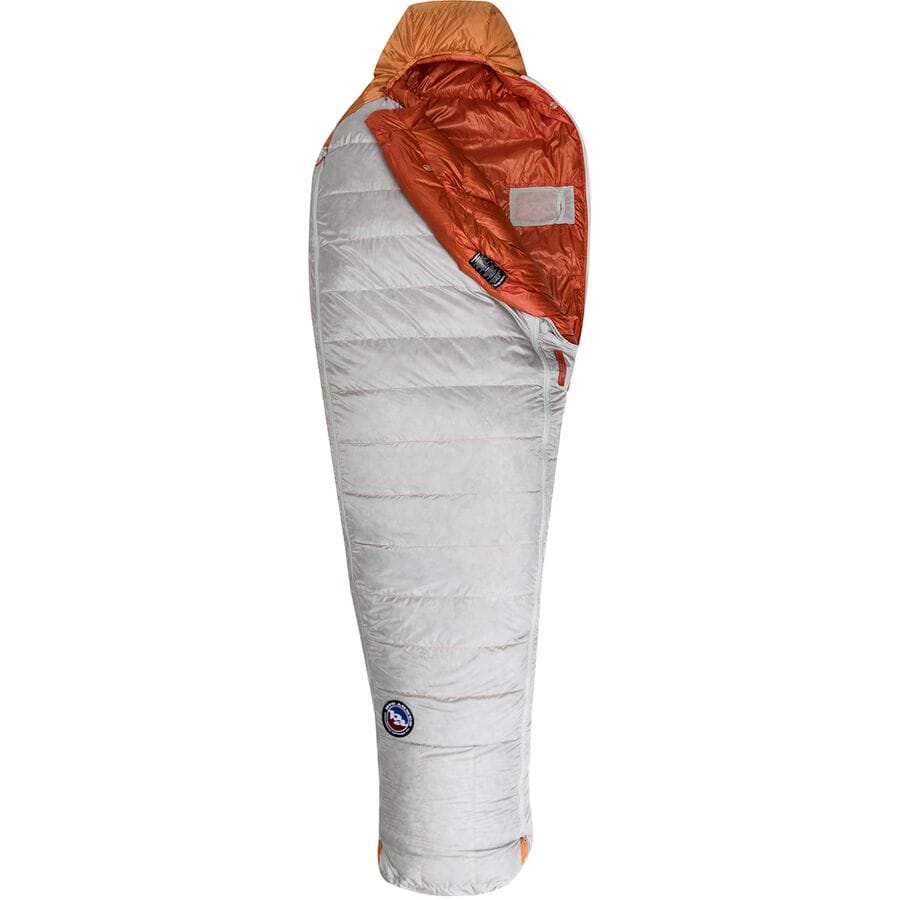
Best sleeping bags for thru-hiking: Big Agnes Torchlight UL.
MSRP: $450 (reg. length)
Weight (Torchlight 20): 36 ounces (women’s: 37 ounces)
Fill Weight: 17 ounces (women’s: 20 ounces)
Fill Ratio: 0.47 (women’s: 0.54)
Temperature Rating: 20 or 30 degrees
Comfort Rating (Torchlight 20): 27 degrees (women’s: 24 degrees)
Insulation: 17 ounces of 850-fill DownTek hydrophobic down (women’s: 20 ounces)
Details
This lightweight offering from Big Agnes has one of the company’s highest warmth-to-weight ratios. It has luxurious 850-fill water-resistant down, but the Torchlight’s dual side expanders are its true claim to fame. The expanders are controlled by two-way, full-length zippers on either side of the bag and can be unzipped to provide about five inches of additional space.
It’s nice to zip the expanders to minimize drafts on chilly nights and still have the option to loosen the bag up for a roomier, more relaxed night’s sleep when it’s not freezing. Our reviewer, who describes himself as a “rotisserie chicken sleeper” who tosses and turns all night, loved that the expandable Torchlight could accommodate side and stomach sleeping. You can also partially unzip the expanders to accommodate wider hips or shoulders while minimizing air gaps elsewhere.
Materials and Features
The Torchlight UL is loaded with 850-fill DownTek (treated, hydrophobic) and a nylon ripstop face fabric also treated to be water-resistant. The draft tube along the zipper, combined with the draft collar under the hood, offers even more protection.
Nobody’s Perfect
At 36 ounces, this “ultralight” sleeping bag is one of the heaviest offerings on our list, even though it has the premium materials and price tag of a fast and light model. Still, this is likely the price one pays for the extra girth and zippers afforded by the side expanders. Some users also complain that the zipper has a tendency to stick.
Read our review of the Big Agnes Torchlight UL 20.
NEMO Forte 35 Men’s | Women’s (Best Synthetic Backpacking Sleeping Bag)

Best sleeping bags for thru-hiking: NEMO Forte 35.
MSRP: $170 (reg. length)
Weight: 34 ounces (women’s: 41 ounces)
Fill Weight: 17 ounces (women’s: 25)
Fill Ratio: 0.5 (women’s: 0.61)
Temperature Rating: 35 degrees
Comfort Rating: 40 degrees (women’s: 32 degrees)
Insulation: 17 ounces of PrimaLoft RISE 80% PCR (women’s: 25 ounces)
Details
Synthetic sleeping bags can’t yet compete with down for weight and packability, they wipe the floor with their feather-filled competitors when it comes to budget. And for a warm-weather bag like the 35-degree Forte, there’s little enough insulation that a synthetic bag still remains feasible in terms of weight and bulk.
NEMO’s signature Thermo Gills (the orange slash thingies in the picture above) can be opened to dump heat on warm nights or zipped up to trap heat when the mercury drops.
Materials and Features
DWR-treated 30d polyester ripstop shell fabric helps to keep moisture from penetrating the bag’s insulated core (and the synthetic insulation there will retain loft when wet). NEMO uses a special version of PrimaLoft that’s meant to maximize warmth and minimize weight and bulk, bringing the material closer to down in terms of performance. It’s also made with 80% post-consumer waste.
The Forte is doubtless significantly lighter than many other synthetic bags in a similar temperature range and is comparable in weight to many 650-fill down bags in a similar temperature range.
Nobody’s Perfect
Although the Forte is competitive among 35-degree bags, many cold sleepers and thru-hikers whose journeys will span colder months will find this temperature rating inadequate. Remember, 35 degrees is the tested lower limit beyond which an average warm sleeper might experience hypothermia; the limit for a comfy night’s sleep is a balmy 40 degrees.
The 20-degree Forte costs $200 and weighs 46 ounces.
Kelty Cosmic 20 Men’s | Women’s (Best Budget Down Sleeping Bag)

Best sleeping bags for thru-hiking: Kelty Cosmic 20.
MSRP: $165
Weight (Cosmic 20): 42 ounces (women’s: 55 ounces)
Fill Weight: 16 ounces (women’s: 31 ounces)
Fill Ratio: 0.38 (women’s: 0.56)
Temperature Rating: 0, 20, or 40 degrees
Comfort Rating (Cosmic 20): 32 degrees (women’s: 25 degrees)
Insulation: 16 ounces of 550-fill down
Details
Kelty’s Cosmic down sleeping bag may not be the most affordable bag on this list (that honor belongs to the synthetic Marmot Trestles), but it comes darn close. At $165 for the regular length, 20-degree model, it’s the only down sleeping bag of backpacking quality that costs about the same as your average synthetic offering. Although the Cosmic underperforms compared to other down bags, it’s still superior to synthetics in weight, packability, and comfort.
Two pounds, 1o ounces isn’t exactly lightweight, but it’s still an acceptable weight for a thru-hike. The bag’s 21-degree temperature rating (32 degrees for comfort) puts it comfortably within the target temperature range for most thru-hikes. The latest update to this classic bag includes trapezoidal box baffles, which allow down to pile up under the seams to minimize heat loss, and a trapezoidal footbox that allows your tootsies to lay more naturally.
Materials and Features
Kelty keeps the price of this bag down by using not-so-premium 550-fill duck down and nylon taffeta shell (not quite as durable as nylon ripstop). Previous incarnations of this sleeping bag used a combination of down and synthetic fill, but after a recent update, the Cosmic line now features 100% down insulation. The shell features C0 and PFC-free DWR treatment.
Nobody’s Perfect
The Cosmic is on the heavy side for a down backpacking sleeping bag. The polyester taffeta lining is also somewhat rough feeling compared to the silky-smooth nylons common in many premium bags.
More of the Best Thru-Hiking Gear of 2023
Why should you trust us?
Because we’re so incredibly intelligent! Attractive, too. (Not to mention extremely humble).
But if that isn’t enough to impress you, there’s also the fact that everyone who contributed to this article is an experienced thru-hiker with thousands of on-trail miles under their belt. We’re gear nerds who love putting our equipment to the test on trails long and short, and we’ve tested dozens of sleeping bags in pursuit of a better night’s sleep in the backcountry.
Moreover, we survey hundreds of Appalachian Trail thru-hikers every year to learn about their behaviors, demographics, and—you guessed it—gear preferences. That means our picks for the best backpacking sleeping bags for thru-hiking aren’t just our opinions: they’re based on years of feedback from the thru-hiking community.
Check out AT hikers’ favorite backpacking sleeping bags for thru-hiking according to the 2018, 2019, 2021, and 2022 thru-hiker surveys.

Competence and backpacking proficiency personified.
Original article by Maggie Slepian. Alex “GPS” Brown and Rachel Shoemaker contributed to the most recent update of this list.
Featured image: Graphic design by Chris Helm.
This website contains affiliate links, which means The Trek may receive a percentage of any product or service you purchase using the links in the articles or advertisements. The buyer pays the same price as they would otherwise, and your purchase helps to support The Trek's ongoing goal to serve you quality backpacking advice and information. Thanks for your support!
To learn more, please visit the About This Site page.

 ">
">
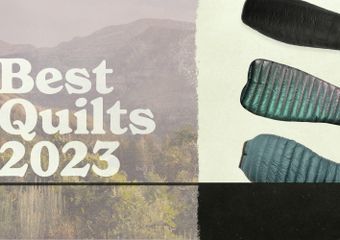
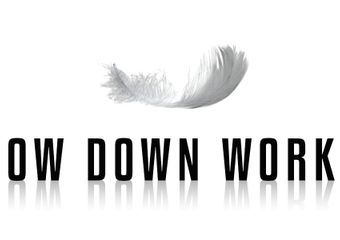

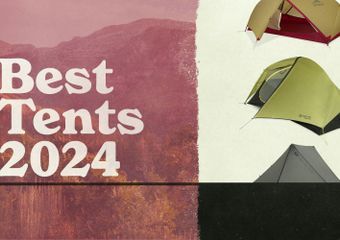
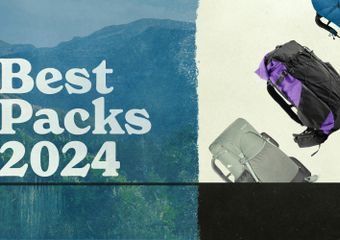
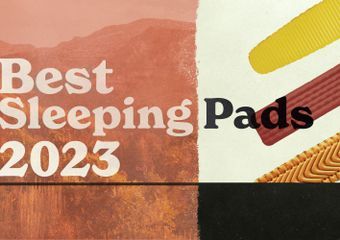


Comments 14
Hi, I’d love know how many of the sleeping bags could accommodate a pillow in the hood area. It’s hard to tell from the photos. Thanks!
Thank you for the super informative article, this was extremely helpful as I am in the process of “upgrading” my bag. I currently have the REI Joule 21 which is a solid bag, but am looking for something warmer and am also hoping to find something that isn’t as constricting around the head/neck area. I was wondering if you or anyone had any recommendations for stomach sleepers? I know I’m not the norm and I have tried to change my sleep position as I know it’s not conducive to camping but if anyone has found a bag that has worked for them or one that they think might work, I’d really appreciate it! 🙂
I may be biased…. but no love for the Hyke and Byke?! 800-fill down for ~$200 and fun colored bags….. literally cannot beat it. A budget backpackers dream.
I’m in the market for a bag so I appreciate this article. I’m also looking at the Rab Mythic ultra 360. Any reason you decided not to include it in your analysis?
I have to note that the Magma is often on sale. That is the only way to buy it.
When you say „limit temperature is what keeps you from freezing to death“, that’s not quite accurate. The way you phrase it it’s more what is being referred to as „extreme temperature“ in general, and typically that’s well below „limit temperature“. The European standard for sleeping bags defines „limit temperature“ where a male sleeper in base layers can still get a decent night of sleep when crouched up in embryo position, ie no significant shivering.
Stefan, yeah OK that is a fair point. *Melodrama alert*
The post has been updated to reflect that more accurate language.